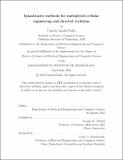| dc.contributor.advisor | Church, George M. | |
| dc.contributor.author | Padia, Umesh Janak | |
| dc.date.accessioned | 2023-01-19T19:56:32Z | |
| dc.date.available | 2023-01-19T19:56:32Z | |
| dc.date.issued | 2022-09 | |
| dc.date.submitted | 2022-10-19T18:58:25.100Z | |
| dc.identifier.uri | https://hdl.handle.net/1721.1/147531 | |
| dc.description.abstract | Multiplexed screening through pooled libraries has gained traction in engineering biological behavior. In particular, it has been effective at controlling cells, designing proteins, determining targets for gene therapy, and developing small molecule drugs. This thesis contributes to cellular engineering and multiplexed screening in three projects. First, this thesis introduces a sequence-aware probabilistic model for cellular transcription that may be applied to library-scale cellular engineering screens. The model outperforms recently published single-cell models on key classification metrics. Next, this thesis introduces a multiplexed in vivo pipeline to engineer T-cell migration to solid tumors. The application of this pipeline recapitulates known homing factors associated with T-cell migration to melanoma. Finally, this thesis demonstrates a versatile distributed system to guide the design of proteins in directed evolution experiments and is generally applicable to all multiplexed library screens. | |
| dc.publisher | Massachusetts Institute of Technology | |
| dc.rights | In Copyright - Educational Use Permitted | |
| dc.rights | Copyright retained by author(s) | |
| dc.rights.uri | https://rightsstatements.org/page/InC-EDU/1.0/ | |
| dc.title | Quantitative methods for multiplexed cellular engineering and directed evolution | |
| dc.type | Thesis | |
| dc.description.degree | S.M. | |
| dc.contributor.department | Massachusetts Institute of Technology. Department of Electrical Engineering and Computer Science | |
| mit.thesis.degree | Master | |
| thesis.degree.name | Master of Science in Electrical Engineering and Computer Science | |
